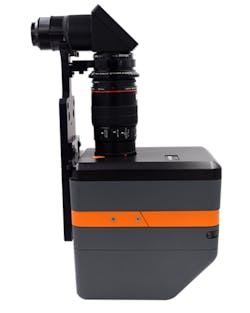XRE Lens
The XRE Lens has a unique optical design specifically engineered for measuring near-eye displays, such as those integrated into virtual (VR), mixed (MR), and augmented reality (AR) headsets. The lens design simulates the size, position, and field of view of the human eye to measure displays as seen by the user—and offers additional advantages including electronic focus control, folded and non-folded configurations, and dual-eye measurement.
- Replicates human eye in XR headsets
- Electronic focus with software control
- Folded ("periscope") or non-folded configuration
- Field of view up to ±35° (70° total)
Evaluate XR Displays from the Eye Position in Headsets
The XRE Lens is designed with a virtual aperture in front of the lens, enabling the system’s optical entrance pupil to be located at the same position as the user’s eye in the headset. From this near-eye position, the connected imaging system can capture a 70° display field of view (FOV) as seen by the user, without obstruction by the headset hardware. All aspects of the display visible to the user are comprehensively measured to ensure the intended experience.
Having no hardware, the virtual aperture of the XRE Lens solution also eliminates concerns about mechanical restrictions when positioning the entrance pupil in the headset. This provides flexibility to emulate human pupil size and ensure proper eye relief distance.
Electronic Focus: Instantly Adjust to Multiple Focal Planes
Extended reality (XR) optical designs may incorporate multiple or variable focal planes to create a more realistic view of objects near and far. To assess these elements correctly, the measurement system must be capable of focusing at multiple distances.
Traditional manual-focus lenses increase measurement setup time and introduce risk of error. Focus settings may be imprecise or shift during the measurement process. With extension-focus lenses, the barrel of the lens changes length while focusing, causing the measurement system’s entrance pupil to move from the eye position. This requires equipment to be repositioned for subsequent measurements.
The XRE Lens’s electronic focus capability eliminates these issues to provide optimal measurement efficiency. Precise focal distances can be set in the software to instantly focus the lens to specific virtual distances (0.5 m to infinity). Because the XRE Lens uses an internal-focus macro lens, the lens body does not change length when focus is changed. This means the XRE Lens system can be adjusted without manual intervention or repositioning, enabling fully automated inspection with focus settings controlled via software. Electronic focus also enables automated Through-Focus MTF analysis, iterating through focus settings until best focus is found across the measurement image, and completing the analysis in a matter of seconds.
Example of Through-Focus MTF analysis in TT-ARVR™ Software; the XRE Lens system has run through more than 30 focus settings for each measurement region (see inset measurement image) to determine the best-focus result at approximately 3560 motor counts.
Flexible Configuration Options for Unique Measurement Scenarios
The XRE Lens solution has multiple configuration options to address the measurement requirements of unique display types, fields of view, resolutions, and form factors. Depending on the measurement need, the XRE Lens can be paired with an imaging colorimeter or imaging photometer. Resolution options up to 61 megapixels provide the necessary pixels per degree for the field of view (up to 70° V x H).
Additionally, folded and non-folded lens options achieve near-eye measurement positions across diverse headset form factors, regardless of straps or other headgear. Folded configurations also support two XRE Lens systems in a headset at once for simultaneous dual-eye (stereoscopic) measurement of left and right-eye positions—ensuring display quality is evaluated under the same conditions as viewed by the user.
XRE Lens solutions are available with the following configuration options:
- Imaging System:
- Photometric (luminance only)
- Colorimetric (luminance & chromaticity)
- Resolution:
- 29 megapixels
- 45 megapixels
- 61 megapixels
- Lens Configuration:
- Folded (“Periscope”)
- Non-Folded
- Additional:
- Standard solution (single XRE Lens system)
- Dual-eye solution (two integrated XRE Lens systems)
Pair with ProMetric Photometers and Colorimeters
Paired with a Radiant ProMetric® Imaging Photometer or Colorimeter and software, the XRE Lens provides a complete solution for accurate and efficient in-headset display measurement. The XRE Lens attaches to a Radiant ProMetric Y Imaging Photometer or ProMetric I Imaging Colorimeter using a custom mounting bracket to ensure stability during movement or vibration. By mounting a lens directly to a ProMetric system, the XRE Lens provides a turnkey, compact camera/lens solution for rapid deployment of XR display testing requiring minimal setup and integration time, equipment, or expertise.
Software Toolset for AR/VR Display Measurement
TrueTest™ Software offers the comprehensive range of Radiant’s display measurement capability and the ability to sequence tests for rapid automated evaluation of all relevant display characteristics in a matter of seconds. Developed specifically for AR/VR display testing, the TrueTest TT-ARVR™ software module measures luminance, chromaticity, contrast, uniformity, mura (blemishes), pixel and line defects, and adds unique tests for XR display analysis such as MTF, distortion, and focus uniformity.
With a complete Radiant solution configured for exact application needs, manufacturers can realize an efficient measurement process using a single provider with global end-to-end support.
XRE Lens Key Features and Highlights:
- Designed for in-headset display evaluation including measurement of photometric values
- Electronic focus for focus setting and adjustment from software
- No manual adjustment needed for each focus change
- Enables fully automated Through-Focus MTF testing
- Entrance pupil (aperture) in front of lens to simulate human eye position
- Virtual aperture (3.3 mm) enables flexible positioning at various eye relief distances
- System FOV up to ±35° (70° total)
- Pairs with high-resolution ProMetric imaging colorimeters and photometers
- Easy-to-use measurement control and analysis software


